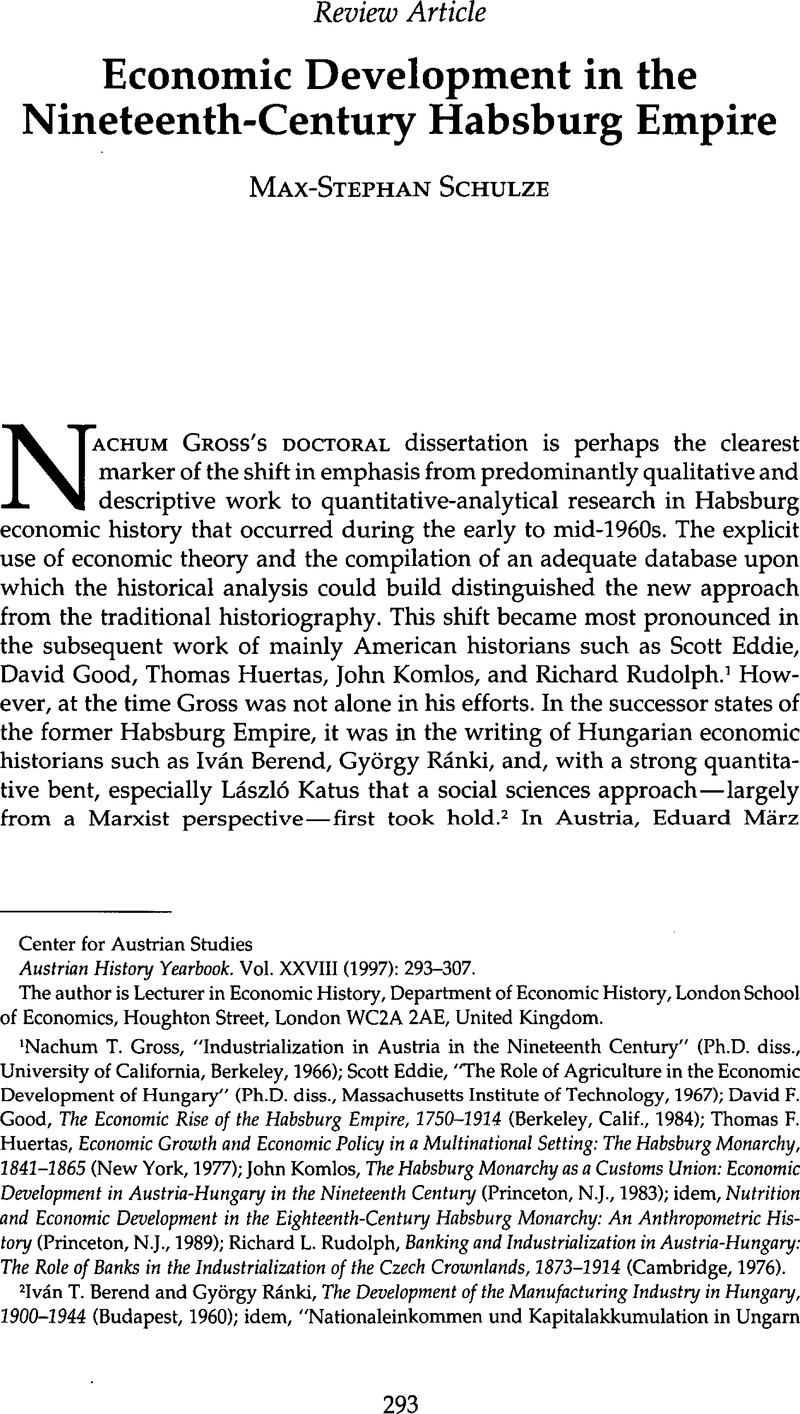Article contents
Economic Development in the Nineteenth-Century Habsburg Empire
Published online by Cambridge University Press: 10 February 2009
Abstract

- Type
- Review Article
- Information
- Copyright
- Copyright © Center for Austrian Studies, University of Minnesota 1997
References
1 Gross, Nachum T., “Industrialization in Austria in the Nineteenth Century” (Ph.D. diss., University of California, Berkeley, 1966)Google Scholar; Eddie, Scott, “The Role of Agriculture in the Economic Development of Hungary” (Ph.D. diss., Massachusetts Institute of Technology, 1967)Google Scholar; Good, David F., The Economic Rise of the Habsburg Empire, 1750–1914 (Berkeley, Calif., 1984)Google Scholar; Huertas, Thomas F., Economic Growth and Economic Policy in a Multinational Setting: The Habsburg Monarchy, 1841–1865 (New York, 1977)Google Scholar; Komlos, John, The Habsburg Monarchy as a Customs Union: Economic Development in Austria-Hungary in the Nineteenth Century (Princeton, N.J., 1983)CrossRefGoogle Scholar; idem, Nutrition and Economic Development in the Eighteenth-Century Habsburg Monarchy: An Anthropometric History (Princeton, N.J., 1989)Google Scholar; Rudolph, Richard L., Banking and Industrialization in Austria-Hungary: The Role of Banks in the Industrialization of the Czech Crownlands, 1873–1914 (Cambridge, 1976).CrossRefGoogle Scholar
2 Berend, Iván T. and Ránki, György, The Development of the Manufacturing Industry in Hungary, 1900–1944 (Budapest, 1960)Google Scholar; idem, “Nationaleinkommen und Kapitalakkumulation in Ungarn 1867–1914,” in Social-Economic Researches on the History of East-Central Europe, ed. Pamlényi, E. (Budapest, 1970)Google Scholar; idem, Economic Development in Central and South-Eastern Europe in the Nineteenth and Twentieth Centuries (New York, 1974)Google Scholar; idem, Underdevelopment and Economic Growth: Studies in Hungarian Social and Economic History (Budapest, 1979)Google Scholar; Katus, László, “Economic Growth in Hungary during the Age of Dualism, 1867–1918,” in Social Economic Researches, ed. E. Pamlényi.Google Scholar
3 März, Eduard, Österreichische Industrie- und Bankpolitik in der Zeit Franz Josephs I. Am Beispiel der k. k. priv. Österreichischen Credit-Anstalt für Handel und Gewerbe (Vienna, 1968)Google Scholar; idem, “Zur Genesis der Schumpeterschen Theorie der wirtschaftlichen Entwicklung,” in On Political Economy and Econometrics: Essays in Honour of Oskar Lange (Warsaw, 1965)Google Scholar; Matis, Herbert, Österreichs Wirtschaft 1848–1913. Konjunkturelle Dynamik und gesellschaftlicher Wandel im Zeitalter Franz Josephs I. (Berlin, 1972).Google Scholar
4 Komlos, John, ed., Economic Development in the Habsburg Monarchy in the Nineteenth Century: Essays (Boulder, Colo., 1983)Google Scholar; idem, Economic Development in the Habsburg Monarchy and in the Successor States (Boulder, Colo., 1990)Google Scholar; Matis, Herbert, ed., The Economic Development of Austria since 1870 (Cambridge, 1994).Google Scholar
5 The most recent exposition of the failure hypothesis is Gerschenkron's, AlexanderAn Economic Spurt That Failed (Princeton, N.J., 1977).Google Scholar
6 Komlos, , Nutrition and Economic Development.Google Scholar
7 Good, David F., ed., Economic Transformations in Eastern Europe: Legacies from the Past and Lessons for the Future (London, 1994).Google Scholar
8 Hence this is not a comprehensive survey of Habsburg historiography, and some important recent books are not discussed here as they fall outside the thematic or chronological focus of this review. For example, the sequel to März's 1968 study of the Creditanstalt in the nineteenth century, Österreichische Bankpolitik in der Zeit der groβen Wende, 1913–1923 (Vienna, 1981)Google Scholar, deals with a considerably shorter period and is primarily concerned with wartime finance, the transition to the First Republic, and the problems of inflation and stabilization during the early 1920s. However, both volumes are recommended as perhaps the best recent examples of noncliometric research in Austrian economic history, drawing on a large array Of archival and published sources. Roman Sandgruber has produced a detailed study of the eighteenth- and nineteenth-century origins of the consumer society: Die Anfänge der Konsumgesellschaft. Konsumgüterverbrauch, Lebensstandard und Alltagskultur in Österreich im 18. und 19. Jahrhundert (Munich, 1982).Google Scholar His most recent Ökonomie und Politik. Österreichische Wirtschaftsgeschichte vom Mittelalter bis zur Gegenwart (Vienna, 1995)Google Scholar, part of a ten-volume Österreichische Geschichte and directed primarily at the nonspecialist reader, offers a broad overview and covers a period of more than a thousand years.
9 Good, , Economic Rise of the Habsburg Empire, 92–94.Google Scholar
10 Ibid., 256.
11 Ibid., 253.
12 Ibid., 173.
13 Mosser, Alois, Die Industrieaktiengesellschaft in Österreich 1880–1913. Versuch einer historischen Bilanz- und Betriebsanalyse (Vienna, 1980).Google Scholar
14 Schulze, Max-Stephan, Engineering and Economic Growth: The Development of Austria-Hungary's Machine-Building Industry in the Late Nineteenth Century (Frankfurt and New York, 1996).Google Scholar
15 März, Eduard, “Die wirtschaftliche Entwicklung der Donaumonarchie im 19. Jahrhundert,” Wirtschaft und Gesellschaft (1985): 367–92.Google Scholar
16 Mosser, Alois, review of The Economic Rise of the Habsburg Empire, 1750–1914Google Scholar, by Good, David F., Mitteilungen des österreichischen Staatsarchivs 4 (1987): 450, 454.Google Scholar
17 Komlos, , Nutrition and Economic Development.Google Scholar
18 In the second part of the book Komlos extends his model to England and preindustrial economic growth in general.
19 Mosser, , Die IndustrieaktiengesellschaftGoogle Scholar; Brousek, Karl M., Die Groβindustrie Böhmens 1848–1918 (Munich, 1987)Google Scholar; Mathis, Franz, Big Business in Österreich, vol. 1: Österreichische Groβunternehmen in Kurzdarstellungen (Munich, 1987), and vol. 2Google Scholar: Wachstum und Eigentumsstruktur österreichischer Groβunternehmen im 19. und 20. Jahrhundert. Analyse und Interpretation (Munich and Vienna, 1990).Google Scholar
20 Good, David F., “The Economic Lag of Central and Eastern Europe: Income Estimates for the Habsburg Successor States, 1870–1910,” Journal of Economic History 54, no. 4 (1994): 869–91.CrossRefGoogle Scholar
21 Webb, Steven B., “Tariffs, Cartels, Technology and Growth in the German Steel Industry, 1879 to 1914,” Journal of Economic History 40, no. 2 (1980): 309–29.CrossRefGoogle Scholar
22 Tilly, Richard, “Entwicklung an der Donau. Neuere Beiträge zur Wirtschaftsgeschichte der Habsburger Monarchie,” Geschichte und Gesellschaft 15 (1989): 407–22.Google Scholar
- 1
- Cited by




